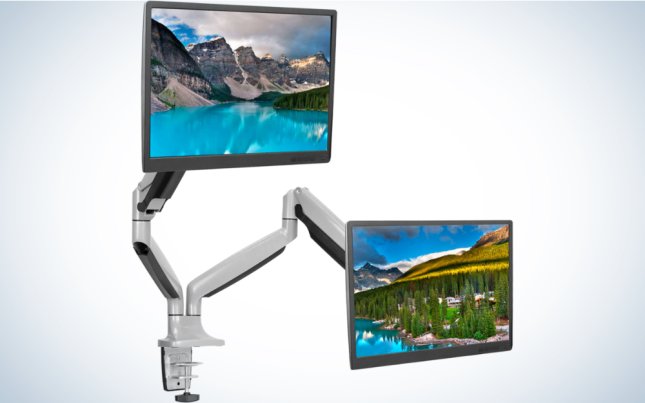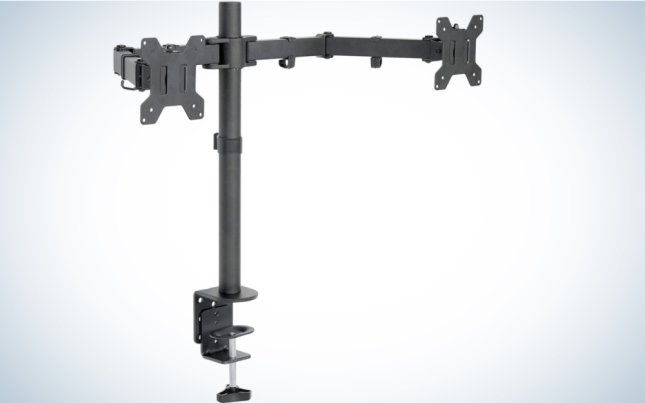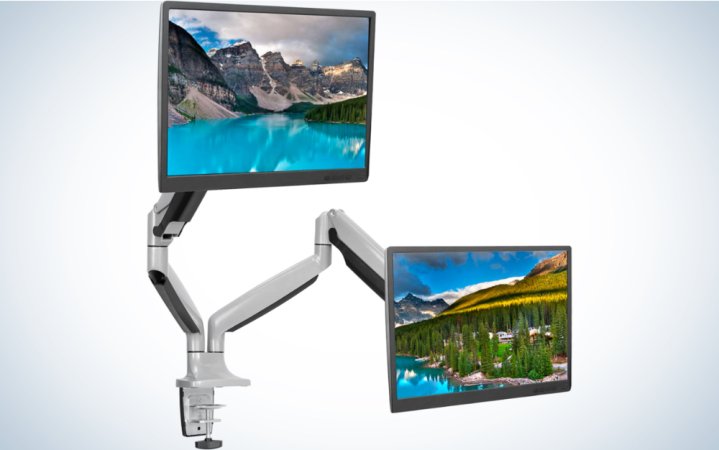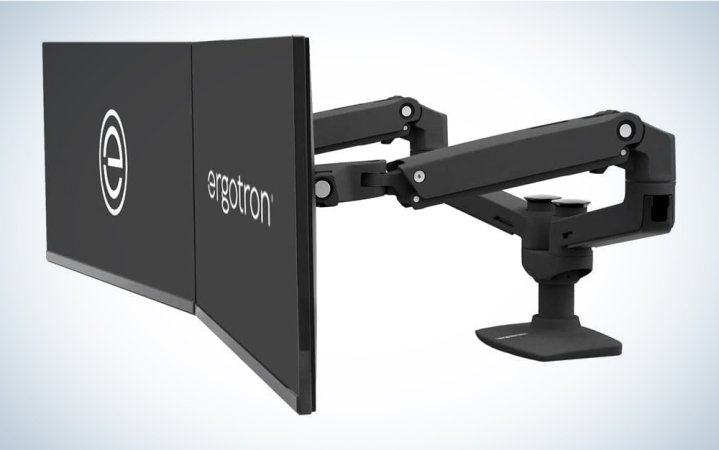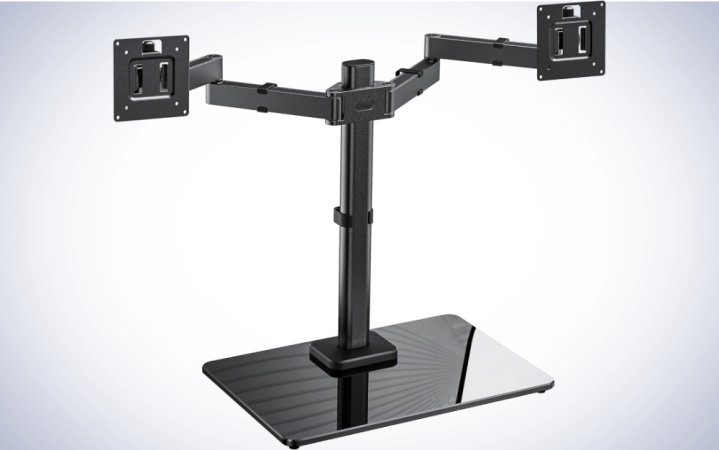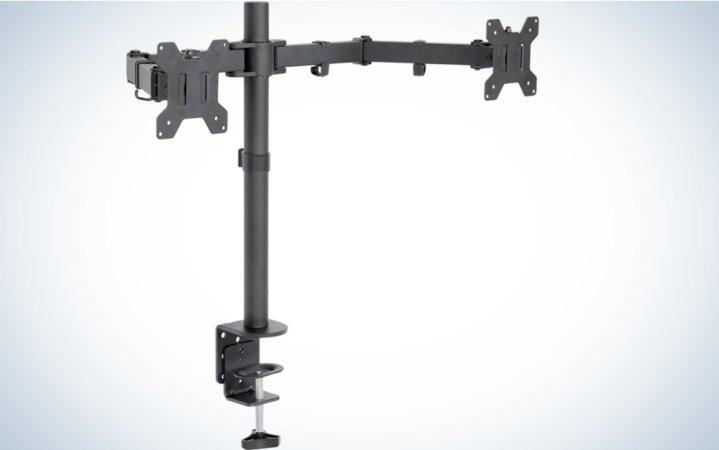We may earn revenue from the products available on this page and participate in affiliate programs. Learn more ›

Using a dual-monitor stand, whether it’s something you put on your desk, a mounted monitor arm, or a bracket you mount on your wall, gives you the freedom to place your screens as you please for both maximum comfort and efficiency. There are many ways to optimize your two-monitor setup: The best dual-monitor stands ensure maximum flexibility, regardless of your approach.
- Best overall: Mount-It! (MI-1772) Dual Monitor Arm
- Best desk-mounted: Ergotron LX Dual Monitor Arm
- Best wall-mounted: Mountup Dual Monitor Wall Mount
- Best freestanding: ErGear Freestanding Dual Monitor Stand
- Best vertical: Hemudu HT05B-002 Dual Monitor Stand
- Best premium: Ergotron HX Desk Dual Monitor Arm
- Best budget: VIVO Dual Monitor Desk Mount
How we chose the best dual-monitor stands
To make our selections, I paired my own personal testing and experience with professional reviews and consumer feedback on Amazon. Our favorite monitor arms and monitor stands for dual-display setups provide a wide range of use cases, installation types, and prices. We also kept brand credibility in mind: Among monitor arm manufacturers, there are a handful of respected companies and many lesser-known brands that often offer cheap prices but without the reputation or warranty to back them up.
Best dual-monitor stands: Reviews & Recommendations
So you have two monitors, and you want to put them up on a single adjustable stand. Now that you know the basics of what to look for, we have a few recommendations for the best dual-monitor stands, including desk-mounted, the best TV wall mounts, and freestanding options. No matter your home office or PC gaming setup, there should be a decent option for you among these picks.
Best overall: Mount-It! (MI-1772) Dual Monitor Arm
Pros
- Requires very little desk space
- Offers fine-grain control over the monitors
- Easy-to-move displays
Cons
- Price
Buy it used or refurbished: eBay
Why it made the cut: Mount-It’s monitor arm makes it very easy to maneuver two big displays without any friction.
Specs
- Mount type: Desk
- Compatible VESA mount sizes: 75mm x 75mm, 100mm x 100mm
- Adjustment mechanism: Gas-spring mount/free moving
- Weight range: 20lb per arm
- Display size range: 19-32 inches
- Available colors: Black, Silver
- Price: $121
We’ve had great success in our tests of Mount-It!’s single monitor arms, and feel very comfortable recommending this dual-display version to anyone who needs a lot of extra digital real estate to work. The arms can hold large, heavy displays, and each one can be twisted, tilted, and turned in several directions. This level of control can accommodate many work styles: video editors who want to see how their color grading tweaks are affecting the look of footage in real time, office workers who want to dedicate a vertically oriented monitor to their e-mail or messaging client, or gamers who want to monitor their Twitch chat.
Two features that impressed us with Mount-It!’s other monitor stands apply to this one: The ease at which they allow you to control your monitor and how well their clamping mechanism keeps it firmly attached to your desk. We’ve had no issues moving a 27-inch monitor with one hand, and the ability to move your displays closer and further from your face comes in handy more frequently than you’d expect. If you don’t have a lot of physical desk space, this monitor’s clamp will be incredibly helpful. A monitor stand’s feet can take up a lot more room than you think, and having more area back for your go-to tech accessories is very useful.
Best desk-mounted: Ergotron LX Dual Monitor Arm
Best desk-mounted dual monitor arm
Fully Covered
Pros
- Superior build quality
- Plenty of ergonomic options
- Easy to install
- Lots of color options
Cons
- Expensive
Why it made the cut: The Ergotron LX Dual Monitor Arm is a slick desk mount that balances great build quality and the price that comes with it.
Specs
- Mount type: Desk
- Compatible VESA mount sizes: 75mm x 75mm, 100mm x 100mm
- Adjustment mechanism: Gas-spring mount/free moving
- Weight range: 7-20 lbs
- Display size range: 27 inches
- Available colors: Black/white/silver
- Price: $297
When you think of monitor mounts, free-moving gas-spring arms typically come to mind. They offer smooth action that allows you to move your screens with precision easily. Though it costs more than many other brands, Ergotron’s LX Dual Monitor Arm dual-monitor arm has a higher quality that justifies the price. Plus, it comes with a 10-year warranty, so you know the company stands behind its product. The Ergotron LX Dual Monitor Arm doesn’t do anything flashy. It just does the basics very well.
Best wall-mounted: Mountup Dual Monitor Wall Mount
Best wall-mounted dual monitor arm
Bolt on and Dial In

Pros
- Great price
- Very adjustable
- Detachable VESA plates
Cons
- Requires tools to install
- Requires brick, concrete, or wood anchor
Buy it used or refurbished: eBay
Why it made the cut: The Mountup Dual Monitor Wall Mount looks sharp, and strikes a balance between price and features.
Specs
- Mount type: Wall mount
- Compatible VESA mount sizes: 75mm x 75mm, 100mm x 100mm
- Adjustment mechanism: Gas-spring arms/free moving
- Weight range: 3.3 – 17.6 lbs
- Display size range: Up to 32-inch
- Available colors: Chrome/Black
- Price: $49
If you’re ready to commit to a specific home, spot, and desk setup, you can save a lot of money on a really great dual-monitor arm with the Mountup Dual Monitor Wall Mount. It looks sharp, carries a lot of weight, and costs less than half as much as our desk-mounted pick. That said, this is a heavy dual-monitor arm. Not only do you need to attach it to the wall, the manufacturer specifically calls for you to anchor it on a brick, concrete, or wooden stud. Drywall alone may not hold it up. That’s a huge limitation, but if you have the right setup, this is arguably the most stable way to mount your monitors.
Best freestanding: ErGear Freestanding Dual Monitor Stand
Best freestanding dual monitor stand
No Installation Required
Pros
- Glass base
- High weight tolerance
- No “install” time
- Price
Cons
- Fewer placement/ergonomic options
- Base takes up space on your desk
Buy it used or refurbished: eBay
Why it made the cut: If you don’t want to mount your monitors on arms, ErGear makes a more conventional dual-monitor stand that’s sturdy and offers strong adjustability.
Specs
- Mount type: Desktop stand
- Compatible VESA mount sizes: 75mm x 75mm, 100mm x 100mm
- Adjustment mechanism: Pole-adjusted height/static arm
- Weight range: Up to 22 lbs
- Display size range: 17-32 inches
- Available colors: Black
- Price: $55
We often recommend desk-clamping or wall-mounted monitor arms for their great adjustability and their ability to free up desk space. However, not all of us can use those options: We can’t all drill holes in our walls, and some desks aren’t clamp-friendly. Whether your options are limited, or you simply don’t want to install anything, a desktop or “freestanding” monitor stand is the way to go.
ErGear’s Dual Monitor Stand features a static base column with adjustable spokes for both monitors. It is as adjustable as a dual-monitor arm, but you can still adjust height, tilt, swivel, and rotation to get very good, ergonomically mind positioning. It’s all held down by a large, sturdy black glass base that has enough room under it to route some cables. While it doesn’t free up as much space as a desk-mounted stand, putting both of your monitors on a single stand still opens up your workstation quite a bit.
Best vertical: Hemudu HT05B-002 Dual Monitor Stand
Best vertical dual monitor stand
No Twist, No Shout

Pros
- Can handle very large and heavy displays
- Has plenty of ergonomic options
- Easy to move
Cons
- Fewer adjustment options compared to free-moving arms
- Still takes up desk space
Buy it used or refurbished: eBay
Why it made the cut: The Hemudu HT05B-002 allows you to set up a vertical stacking configuration without sacrificing stability.
Specs
- Mount type: Desktop stand
- Compatible VESA mount sizes: 50mm x 50mm, 75mm x 75mm, 100mm x 100mm
- Adjustment mechanism: Static mount
- Weight range: 44 lbs per arm
- Display size range: 13-34 inches
- Available colors: Black
- Price: $42
Ergonomics are, ultimately, the core advantage of using a dual-monitor arm. Putting your displays on a single, adjustable mount allows you to position your displays to reduce the number of neck movements you have to do in your daily work. No matter what you do, though, putting two widescreen displays right next to each other ensures that you will need to turn your head to focus on one screen or the other. Suppose you are the kind of person who uses one display most of the time and only occasionally glances at screen number two. In that case, a stacking monitor stand, which mounts the two monitors in a single column, might be useful. Craning your neck to look up isn’t great, ergonomically speaking, but if you only look at that second monitor every once in a while, it may lead to a net reduction in strain.
If you want to set up a vertical stack, we recommend a desktop mount like the Hemudu HT05B-002, rather than a desk-mounted one. With a vertical setup, you’re putting a lot more stress on the stand arm, and a flat stand handles that extra weight better. The HT05B-002 can handle two 34-inch, 44-lb. screens. It features removable VESA plates for easy installation as well. A wide base limits your desk real estate gains, but you can rest easy knowing that the stand will support your monitors’ weight(s). It’s a small consolation, but the feet under the base raise up enough to fit some of your other cabling underneath.
Best splurge: Ergotron HX Desk Dual Monitor Arm
Best premium dual monitor arm
Reliable and Expensive

Pros
- Killer looks
- 15-year warranty
- A trusted name in ergonomics
Cons
- Very expensive
Buy it used or refurbished: eBay
Why it made the cut: If you’re willing to pay a premium for a reliable brand, the Ergotron HX is as sturdy as they come.
Specs
- Mount type: Desk-mounted
- Compatible VESA mount sizes: 75mm x 75mm, 100mm x 100mm (More available with optional bracket adapter kit)
- Adjustment mechanism: Gas-spring arms/free moving
- Weight range: 35 lbs per arm
- Display size range: Up to 32-inch
- Available colors: White, Silver, Black
- Price: $585
It’s easy to find a monitor arm for under $100, but they’re almost always a gamble. You’re buying a relatively untested design from a brand with little to no reputation, which can be a risky proposition with a dual-monitor stand that holds and protects two pieces of equipment that cost hundreds or even thousands of dollars. If you have a pair of very expensive displays, you may want to consider spending a similarly luxurious amount on your stand.
Ergotron is one of the oldest and most reliable names in the monitor stand game, and its HX dual-monitor arm is a deluxe desk-mounted stand. It has some of the flourishes from our other top picks, including a 15-year warranty and detachable VESA mounts for easy mounting. It also features a unique handlebar beneath the screens that allows you to adjust both displays at once. Those things are all just gravy, though. In this case, you’re spending a lot of extra money on the peace of mind that comes with buying a trusted luxury brand.
Best budget: VIVO Dual Monitor Desk Mount
VIVO Dual Monitor Desk Mount
Pros
- Gives you a fair amount of control over your monitors
- Won’t take up a lot of room on your desk
- Price
Cons
- No automatic height adjustment
Buy it used or refurbished: eBay
Why it made the cut: VIVO managed to make its dual-monitor stand comparable to more expensive models without many compromises.
Specs
- Mount type: Desk
- Compatible VESA mount sizes: Gas-spring arms/free-moving
- Adjustment mechanism: 75mm x 75mm, 100mm x 100mm
- Weight range: up to 22lb per arm
- Display size range: 13-30 inches
- Available colors: Black, White
- Price: $28
If you’ve invested most of your home office improvement budget on your new displays, it makes sense to save a little bit on a dual-monitor stand. This model from VIVO has most of the features found in our best overall pick, but at a quarter of the price. Each monitor can be tilted and twisted individually, but you can only adjust their height by loosening and tightening a screw on the back. Both monitors have to be set at the same height, which may matter depending on the type of work you do. This stand works with monitors up to 30-inches wide, but VIVO offers a model that can handle displays up to 32 inches if necessary.
We like monitor arms that can be clamped onto a desk rather than sit on top of it because of the space savings, which is why VIVO’s is especially appealing to us. We’re also impressed that it can control monitors up to 22 pounds, which means the arms on this stand are stronger than the ones on our best overall pick. If the lack of height adjustability isn’t a dealbreaker, there’s no reason to spend more money on a dual-monitor stand.
Things to consider before buying one of the best dual-monitor stands
Even if you know exactly which dual-monitor stand or arm to buy, it helps to know a bit about the basic mechanics involved. Different stands require varying amounts of installation at setup, and not every monitor can be mounted on a third-party stand. Understanding these basics will help you pick the right stand for your displays, and ensure you’re ready to install your stand (or call someone who can.)
Why should I use a dual-monitor stand?
There are many reasons to mount your monitors, ranging from purely cosmetic to enabling better ergonomics. The stands with PC monitors vary widely in construction quality, appearance, and features. Some stands take up tons of desk space without offering any additional utility. Others may not allow you to adjust them properly, forcing you to twist or crane your neck to look at them, which could lead to long-term strain. And some of them may just look ugly. When you buy a monitor for its great specs, which you should, it potentially opens the door for you to end up with a huge, ugly stand that gives you a sore neck. Luckily, most monitors allow you to remove the actual display from its stand and mount them on a third-party stand.
A monitor stand, whether it sits on your desk, clamps on at edge of it, or bolts onto the wall behind it, can solve all of these issues at once, giving you the ability to place your monitor exactly where you want it, reclaiming your desk space for more useful tools, and swapping out what may be garish design for something more subtle and clean.
Stand, clamp, or wall mount?
When moving to a dual-monitor stand, you must choose between a conventional desktop form factor, a clamping desk-mounted design, or a wall-mounted one. Often, picking one versus another comes down to what kind of desk you have, how important it is to reclaim desk space, and the likelihood that you’ll need to move your setup.
If you have a flat desk with an edge or lip, we like clamping monitor stands that clamp to the rear edge of your desk. They’re sturdy, highly adjustable, and easy to install or remove without damaging the desk. (Some offer an option to drill a hole into your desk as an anchor, but it isn’t necessarily mandatory.)
That said, if you have a glass desk, an executive-style desk, or something with lots of cable guides built into the back, a clamp might not be a good fit. In most cases, there’s just no spot to install the clamp. With glass, it could literally shatter the desk. In those cases, a desktop stand makes more sense. Though you won’t get as much space back, a desktop with a dual-monitor stand still consolidates two screens onto a single stand, reclaiming some desk real estate. Also, desktop stands are very sturdy, so it makes sense to use them for larger, heavier screens.
Finally, there’s the wall mount. Whether you use a set of monitor arms or a bracket similar to what you’d use when mounting a TV, the wall mount is an extremely sturdy choice but requires serious installation. To install it, you’ll need to find a stud, drill some holes, and bolt your monitor stand to your wall. Once you install it, your monitor stand isn’t going anywhere, which means your desk setup isn’t going anywhere, either. That lack of flexibility makes it a very niche choice. You don’t want to have to spackle and repaint your walls every time you think your desk would look better over by the window.
Before you buy: Make sure all your monitors have VESA mounts
If you peek around the back of most computer monitors, you’ll notice that the stand for your display probably attaches via four screws in a square configuration. This is a standard configuration maintained by the Video Electronics Standards Association, commonly known as VESA, meant to make stands as close to universal as possible so users can buy new stands easily.
VESA mounts can come in many sizes, but most PC monitors fall into one of two options, 75mm x 75mm or 100mm x 100 mm. That makes everyone’s life easier: All of our picks support both sizes, as should most third-party monitor stands of any shape and size. That said, you should still double-check your monitors’ specs to see VESA mount sizes you’ll need before buying a dual-monitor stand, if only to ensure your monitor can be mounted. Some very cheap monitors (and a few very expensive ones) build their monitors permanently attached to their stands.
Double-check the weight of both of your displays
Monitors are heavy and expensive. Before mounting them, you should ensure your stand can support their weight. Make sure that your monitors are within the stands’ specified weight limit—don’t risk going above or below whatever limits the manufacturer sets. Most monitor manufacturers include the weight of the displays both with and without stands on their product pages. You have a little wiggle room on the size of the monitor, but consider the weight tolerances to be inviolable laws of nature in this case, or risk breaking hundreds or even thousands of dollars worth of monitors.
FAQs
Desk- and wall-mounted monitor arms do double duty, clearing off desktop space and improving your PC setup’s ergonomics. With your monitor on a desk-mounted stand, you can remove the original stand from your desk, giving you back some desk space. You can leave that space open for a cleaner, more minimalist look, use it as a spot to store a laptop, or maybe take advantage of it as a home for some powered speakers? The sky’s the limit.
The maximum weight your dual-monitor stand can hold will vary from stand to stand. The mounts we’ve selected for this list max out at anywhere from 17.6 lbs to 44 lbs per monitor, influenced by the build material, the type of arm, and mounting style.
This is one of the most important things to check out before picking out an arm. Do not buy a stand unless you are sure it can support your monitors’ weight.
You can use some dual-monitor arms on a glass desk. Avoid using desk-mounted monitor stands, which apply a large amount of clamping force to your desk. A clamping monitor stand may very well crack or shatter the desk. So long as your desk can handle the weight of two monitors, a desktop monitor stand should work fine. If weight is also a concern, consider a wall-mounted stand.
This will vary based on the features you need, but you shouldn’t have to spend over $50 on a monitor stand if your needs are modest.
Final thoughts on the best dual-monitor stands
- Best overall: Mount-It! (MI-1772) Dual Monitor Arm
- Best desk-mounted: Ergotron LX Dual Monitor Arm
- Best wall-mounted: Mountup Dual Monitor Wall Mount
- Best freestanding: ErGear Freestanding Dual Monitor Stand
- Best vertical: Hemudu HT05B-002 Dual Monitor Stand
- Best premium: Ergotron HX Desk Dual Monitor Arm
- Best budget: VIVO Dual Monitor Desk Mount
With so many options for mounting your monitors and such a wide range of prices, the best dual-monitor stands are a very affordable and useful upgrade for anyone using two monitors. Whether you’re rocking one display in landscape mode and one in portrait mode, pairing an ultrawide monitor with a standard one, mounting to a desk or a wall, there are dynamic stands for every type of home setup.
